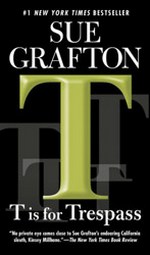 Y is for Yesterday
Y is for Yesterday
by Sue Grafton
Series: Kinsey Millhone, #25Hardcover, 483 pg.
Marian Wood Books/Putnam, 2017
Read: October 24 – 27, 2017

…all I had to do was return the retainer and that would have been the end of it.
But I was already hooked. The little terrier in my nature was busy chasing after the problem, throwing dirt up behind me as I dug my little hole. There was a rat down there somewhere and I would have it for my very own.
It’s this attitude that won me to Kinsey’s side, and has kept me reading her.
Fritz McCabe has just been released from prison — ten years after being given the maximum sentence for being part of a murder as a high school student. Now his parents are being blackmailed with the threatened release of a videotape (seeming?) to show him (and the others involved in the murder) participating in a sexual assault on a drunk/high younger girls. If this tape leaks, he will be put back in prison, doing adult time. The legal bills will destroy his family, and they know that the blackmailer’s demands will eventually do the same. Kinsey’s hired by the parents to put an end to the blackmail. She is, rightly, horrified by the events on the tape, but wants to help the parents.
While she investigates what happened to the tape for the decade-plus since the murder (and the brief time between the making of the tape and the murder), Kinsey investigates the events surrounding the creation of the tape (how consensual was it?, was it just a joke by all involved?) — and keeps brushing up against the murder. What actually happened? We get flashbacks to the day of the murder (and the lead up to it), so that we see a lot more than Kinsey will get exposed to through memories, dishonest witnesses, and news stories. It’s pretty obvious to the reader what actually happened in 1979, and what’s probably going on in 1989, early on — we don’t get the full picture until Kinsey does, but then it’s just confirmation. The final reveal on this was nevertheless very satisfactory — possibly the best part of the book.
Meanwhile, the serial killer from X is still lurking around, trying to find some of the evidence he left behind — and is harassing Kinsey while at it. This is by far the most interesting of the stories, but it can’t seem to keep Kinsey’s attention the way it should. She even notes that herself — clearly it’s something she doesn’t want to think about, and who can blame her? But how do you not think about it? The ending to this story wasn’t as satisfying to me, but it worked, and wasn’t (exactly) what you’d expect.
The flashbacks didn’t work as well for me as they have in previous novels, I’m not sure that I can put my finger on why, but Grafton didn’t pull it off as well. It could be related to the fact that everyone in this story was thoroughly unpleasant — the only person you could kind of like was the girl you knew was going to die. Actually, I liked her a lot — even though in the opening chapter I knew she was going to be dead for a decade by the time Kinsey gets involved. One other member of the group who served time related to the murder has made the best of his life that he can following his release from prison — he’s really turned his life around, and I could admire him (in 1989).
Once things heat up on the serial killer side of things, I really liked everyone involved — it was a collection of great characters. As I write this, I realize just how much I wish the book focused on this story (I honestly didn’t realize that until now). It is really hard to talk about, however, beyond what I’ve said already, so I’ll just leave it at that.
There’s a few things going on in her personal life — with Henry, her cousin, Jonah, etc. I’m not going to bother with it, typical judgmental, cantankerous Kinsey — and that’s about it. I don’t think I’ve ever got too concerned about historical accuracies in these books before, but there were a couple of things that people said that just didn’t seem like 1989 to me, maybe mid-90s. But it didn’t distract me too much or take me out of the story for too long (which is the make or break thing for me when it comes to this kind of thing).
It wasn’t bad, but it sure wasn’t good — Y is for Yesterday will scratch the itch that long-term Kinsey fans have, but won’t do much for newer readers.
—–













